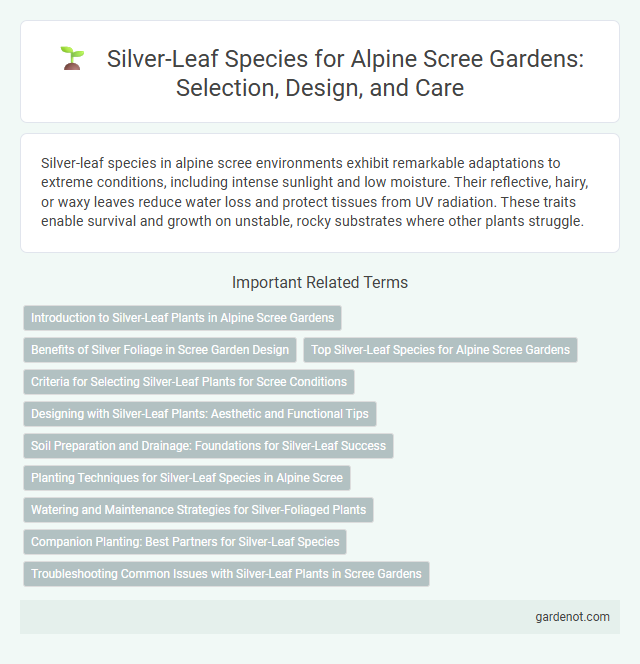Silver-leaf species in alpine scree environments exhibit remarkable adaptations to extreme conditions, including intense sunlight and low moisture. Their reflective, hairy, or waxy leaves reduce water loss and protect tissues from UV radiation. These traits enable survival and growth on unstable, rocky substrates where other plants struggle.
Introduction to Silver-Leaf Plants in Alpine Scree Gardens
Silver-leaf plants in alpine scree gardens exhibit specialized adaptations such as dense trichomes and reflective surfaces that minimize water loss and protect against intense sunlight. These species, including Artemisia and Silene, thrive in nutrient-poor, well-drained rocky substrates characteristic of scree environments. Their silvery foliage not only enhances aesthetic appeal but also plays a critical role in temperature regulation and UV radiation defense.
Benefits of Silver Foliage in Scree Garden Design
Silver-leaf species in alpine scree gardens enhance visual contrast and texture, reflecting sunlight to reduce heat stress and conserve soil moisture. Their reflective foliage supports microclimate regulation, promoting resilience against harsh mountain conditions. These plants also aid in soil stabilization, preventing erosion in rocky, unstable scree environments.
Top Silver-Leaf Species for Alpine Scree Gardens
Silver-leaf species like Artemisia stelleriana, Tanacetum niveum, and Helichrysum italicum thrive in alpine scree gardens due to their drought tolerance and reflective foliage that reduces water loss. These top silver-leaf plants enhance scree landscapes by providing textured, silvery hues that contrast with rugged rocks and sparse greenery. Their deep root systems stabilize loose scree, preventing erosion while supporting biodiversity in harsh mountain environments.
Criteria for Selecting Silver-Leaf Plants for Scree Conditions
Silver-leaf plants chosen for alpine scree conditions must exhibit high drought tolerance, reflecting their ability to thrive in well-drained, rocky soils with minimal water retention. Leaf surface adaptations like dense trichomes or reflective coatings enhance survival by reducing water loss and UV radiation damage. Root systems should be extensive yet shallow to anchor securely in unstable scree while maximizing nutrient uptake in nutrient-poor substrates.
Designing with Silver-Leaf Plants: Aesthetic and Functional Tips
Silver-leaf plants, such as Artemisia and Helichrysum species, bring striking contrast and texture to alpine scree gardens, enhancing visual interest with their soft, reflective foliage. Their natural drought tolerance and ability to thrive in rocky, well-drained soils make them ideal for low-maintenance, sustainable landscape designs. Incorporating silver-leaf species in rock gardens not only improves aesthetics but also supports soil stabilization and reduces erosion in alpine environments.
Soil Preparation and Drainage: Foundations for Silver-Leaf Success
Silver-leaf species thrive in well-drained, rocky soils typical of alpine scree environments, where soil preparation involves enhancing drainage and preventing water retention that can lead to root rot. Incorporating coarse sand or small gravel into the soil mix improves aeration and mimics natural scree substrates, promoting healthy root development. Effective drainage systems combined with soil amendments ensure optimal moisture balance, crucial for the survival and growth of silver-leaf plants in high-altitude, alpine conditions.
Planting Techniques for Silver-Leaf Species in Alpine Scree
Planting silver-leaf species in alpine scree requires selecting well-drained, rocky substrates that mimic their natural habitats to ensure root stability and prevent water retention. Utilizing techniques such as planting during early spring and incorporating gravel mulch around the base improves moisture regulation and protects against frost damage. Careful spacing accommodates growth patterns and airflow, reducing disease risk and promoting healthy development in harsh alpine conditions.
Watering and Maintenance Strategies for Silver-Foliaged Plants
Silver-leaf species in alpine scree thrive with minimal watering, as their drought-resistant foliage reduces moisture loss and supports water conservation. Maintaining well-drained, gritty soil prevents root rot and mimics their natural rocky habitat, ensuring optimal growth and health. Regular removal of dead leaves enhances airflow and reduces fungal diseases, sustaining the plants' vibrant silver appearance.
Companion Planting: Best Partners for Silver-Leaf Species
Silver-leaf species thrive in alpine scree environments when paired with drought-tolerant companions like alpine sedum, creeping thyme, and saxifrage, which stabilize soil and reduce moisture loss. These companion plants enhance nutrient cycling and protect silver-leaf species from harsh mountain winds and midday sun exposure. Strategic planting alongside these partners promotes biodiversity, improves soil retention, and supports the delicate balance of alpine scree ecosystems.
Troubleshooting Common Issues with Silver-Leaf Plants in Scree Gardens
Silver-leaf plants in alpine scree gardens often face challenges such as root rot caused by poor drainage and fungal infections due to excessive moisture. Ensuring well-draining soil with a gritty, sandy mix mitigates water retention issues and promotes healthy root systems. Regular inspection for pests like aphids and timely removal of infected leaves helps maintain plant vigor and prevents the spread of disease.
Silver-leaf species Infographic

 gardenot.com
gardenot.com